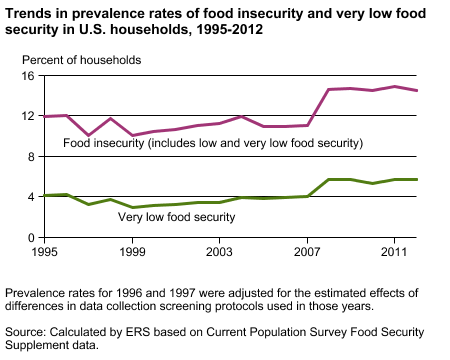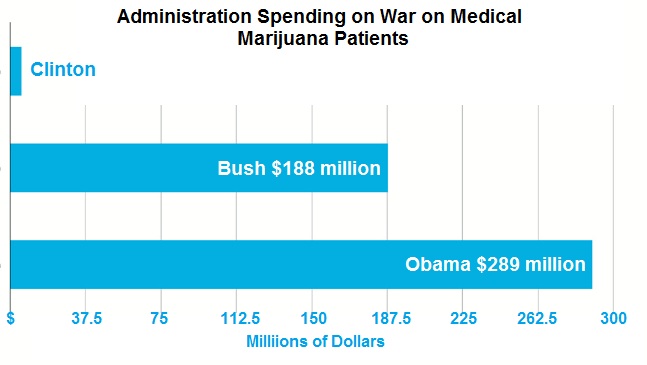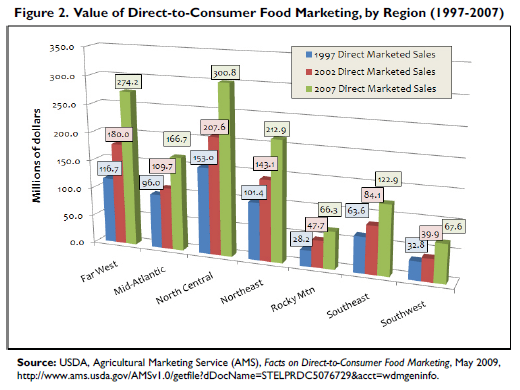| « Stop AIPAC! | Question 8 for 9/11 Smarties: How is it possible that 90% of the occupants in the Twin Towers were evacuated safely on September 11, 2001? » |
National Security vs Food Insecurity: One in seven hungry in US as Obama preps for more war
By Rady Ananda

The number of starving US citizens during Obama’s terms in office is a whopping one in seven, worse than the global average of one in eight. As he continues to pour several hundred billion dollars into the Middle East war theater that will likely soon include Syria, Congress wants to cut $40 billion in food aid to its constituents.
A recent USDA report reveals that nearly 18 million families, or 49 million people, lacked “food security” which is defined as “consistent, dependable access to enough food for active, healthy living.” Food insecurity is a polite term for starvation.
Since 1995, the percent starving in the US hovered at or below 12%. That changed in 2008 when it jumped to 14.6%, and has stayed above 14% since then. In 2012, the percentage was 14.5%, or one in seven people.
Only 59% of those counted as “food insecure” used any of the three major federal food assistance programs, researchers found. They looked at Supplemental Nutrition Assistance Program (food stamps); Special Supplemental Nutrition Program for Women, Infants, and Children (WIC); and the National School Lunch Program.
Though food stamps provide an average of $1.33 per meal for its recipients, Republicrats plan to cut $40 billion over ten years from this essential social service, Think Progress reports. People get nasty when hungry; and many sociologists and historians point to widespread hunger as the cause of most, if not all, major revolutions in world history. Even recent ones. The Romans understood this, ergo the saying, panem et circenses (give the masses ‘bread and circuses’ to appease them and thus retain control).
Despite that one out of seven US citizens goes hungry, Obama, like his predecessors, continues to pour hundreds of billions of dollars into the war machine. At last count, the US spent $684 billion in 2012, or 39% of the total global defense spending, reports Global Issues.
US military spending is down from 2008, when it spent $711 billion, if sources are accurate.
Even so, notes Jobs Not Wars, “If the U.S. cut its military spending in half, it would still outspend China, Russia and Britain together.”
Obama’s Food ‘Security’ Program
Obama’s military spending is ironic given his Global Food Security Initiative announced just months into his presidency, at the April 2009 G20 Summit held in London. As part of a global development strategy, Obama stated his plan to:
“Increase our investments and engagement in development-focused innovation by seeking and scaling up potential game-changing development technologies such as vaccines for neglected diseases, weather-resistant seed varieties, and clean energy technologies.”
The World Food Programme of the United Nations estimates the global hunger rate at one in eight. Under these circumstances, no US president has any business worrying about hunger over there. But that he is, at least superficially.
The food security initiative includes a “Feed the Future” program that established “the Global Agriculture and Food Security Program (GAFSP) – a multilateral trust fund, based at the World Bank and launched by the United States in collaboration with other donors, including private philanthropy — designed to help poor farmers grow, market and earn more.”
In reality, “Feed the Future” is merely a scheme to blanket the planet in genetically modified food and toxic chemicals.
Obama’s concern about homegrown poverty, as we see from bankster bailouts and never-ending war, is nonexistent. He certainly hasn’t bucked long-time federal policy of legalizing slavery under the name minimum wage. No adult can support herself on minimum wage. Hunger is guaranteed under minimum wage.
The War on Farms
Obama's FDA, run by former Monsanto executives, has a peculiar interest in destroying small farming operations in this nation. Nutritious food, grown organically and raised humanely, has been the target of several federally directed raids, supported by local sheriffs and police. No one has been sickened by food sold by these farms, or in the private buying clubs (like Rawsome Foods) that distribute it. But that’s not the point. Instead, the federal government clearly seeks to eliminate giant agribiz competition.
The current war on small US farmers is detailed in David Gumpert’s two books, The Raw Milk Revolution: Behind America’s Emerging Battle Over Food Rights (2009), and Life, Liberty and the Pursuit of Food Rights (2013).
We also see the feds’ real motives in the “Food Safety Modernization Act” (formerly S 510), and the bandaid fix known as the Tester Amendment which was adopted to protect small farms from onerous food safety regulations that would put them out of business. Even former supporters now recognize that the FSMA will devastate small farm operations. The Cornucopia Institute now admits:
“Instead, the regulations would ensnare the country’s safest family farmers in burdensome regulations in a misdirected attempt to rein in abuses that are mostly emanating from industrial-scale factory farms and giant agribusiness food processing facilities.” [emphasis in original]
On the state level, we continue to find news items where children’s lemonade and raspberry stands are being shut down, for failure to acquire a permit. At the city level, feeding the homeless, a time-honored act of charity, has been criminalized across the US. Even fundraising bake sales have been criminalized.
Ron Finley, a self-admitted “gangsta gardener” faced a $400 fine for growing free-for-the-taking vegetables on his tree lawn.
The War on Herbs
The federal government, in line with globalists, also seeks complete control over medicinal and nutritional herbs. By and far, the best advocate protecting our right to natural herbs with which humans evolved is the National Health Federation, the only populist representative on the Codex Alimentarius Commission, a forum ostensibly created to facilitate global trade in foods. Unfortunately, we learn from NHF:
“This will be used to exclude high-potency American supplements and move towards harmonization of the more-liberal U.S. food regulatory regime with the harsh European regulatory model that only allows ridiculously low-potency and expensive supplements to be marketed.”
The “more-liberal U.S. food regulatory regime” is being overturned as we speak, with the introduction of several bills to force natural herbs into a testing protocol more strict, and more expensive, than what pharmaceuticals endure. In opposing hyper-regulation of supplements (as spearheaded by Senator Dick Durbin and others), Dr. Mercola explains:
“Data from the U.S. National Poison Data System’s annual report, which tracked data from 57 U.S. poison centers, showed vitamin and mineral supplements caused zero deaths in 2010, whereas pharmaceuticals caused more than 1,100 of the total 1,366 reported fatalities. FDA-approved drugs cause 80 percent of poison control fatalities each year. Poison control centers report 100,000 calls, 56,000 emergency room visits, 2,600 hospitalizations and nearly 500 deaths each year from acetaminophen (Tylenol) alone.
“Data from the European Union indicate that pharmaceutical drugs are 62,000 times as likely to kill you as dietary supplements. You’re actually more likely to be struck dead by lightning or drown in your bathtub than have a lethal reaction to a dietary supplement. These figures make it quite clear where the danger lies. If Senator Durbin really cared about your health, his efforts would be centered on doing something to make drugs safer, as they obviously pose a FAR greater risk to your health.”
The Dietary Supplement Health and Education Act of 1994 (DSHEA), among other laws, already controls supplements. Instead of enabling enhanced nutrition of its citizens, the feds concern themselves with increasing pharmaceutical profits.
The same can be said for other nations. In 2011, legislation introduced in Australia sought to ban thousands of plants, including its national flower, because they contain DMT, a naturally-occurring hallucinogen that even the human brain produces.
The War on Weed
Though rarely considered in food criminalization discussions, not only does marijuana have medicinal and recreational benefits, but its “seeds contain essential fatty acids and amino acids, which can be baked into foods to boost their nutritional value, in seed oil when sauteing foods, or taken as a supplement,” report Fox, Armentano and Tvert in Marijuana Is Safer So Why Are We Driving People to Drink?
Marijuana Is Safer details numerous medical benefits including anti-carcinogenic properties, preventing epileptic seizures, reducing peripheral neuropathy pain along with other types of pain, and thus reduces opiate dosage needs. It increases craving for food, a boon for those on appetite-suppressing chemotherapy, and it promotes sleepiness.
Not only does marijuana treat the symptoms of disease, Marijuana Is Safer reports, but:
“In some cases, it appears that marijuana can effectively treat disease itself. For instance, marijuana possesses strong antioxidant properties that can protect the brain during trauma and potentially ward off the onset of certain neurological diseases such as Alzheimers.
“In fact, in one of the great political ironies, the U.S. Department of Health and Human Services holds a patent – it’s patent no. 6630507 – on the use of cannabinoids as antioxidants and neuroprotectants. That’s right, the same government that classifies cannabis as a Schedule I illicit drug (which under federal law is defined as possessing ‘no currently accepted medical use in treatment’) owns the intellectual property rights to several of the plant’s naturally occurring, therapeutic chemicals.”
That patent was filed back in 1999, deep amid the war on drugs.
Genetically modified marijuana research has been ongoing for over two decades, detailed by numerous freelance researchers. Several insist that a former agent for the Drug Enforcement Agency, Sam Selezny (aka David Watson aka Skunkman) developed his strains of GM weed in Holland with funding from the DEA. His company, Hortapharm, stands to make billions when pot is fully legalized in the States.
Just as natural, unmodified fresh milk is a market threat to drug-laden, industrial milk; natural, privately grown marijuana is a threat to the GM weed market. And so we see legal marijuana suffering under Obama.
Raids on legal cannabis farming and sales has cost nearly $300 million in the past four years, reports Americans for Safe Access:
Last month, however, we saw some key changes in federal policy. Attorney General Eric Holder announced a “compassionate release” program to let medical marijuana users out of prison. Next, the Dept. of Justice reversed itself by agreeing to allow banks to work with medical marijuana clinics, and agreed to abide by voter decision in Washington and Colorado which allows for recreational use.
The DoJ's policy reversals follow a unanimous resolution adopted by US mayors at their annual conference in June, supporting the notion of “states setting their own marijuana policies without federal interference.”
Food as Trade Commodities
Finally, we cannot discuss starvation without mentioning food commodities. The dissolution of trade barriers and deregulation of the banking sector has led to price manipulation, increasing food insecurity and causing widespread starvation.
F. William Engdahl explains that for over 4,000 years, grains were safely stored for up to seven years to protect against war, drought and famine. That all changed in 1993 with the passage of GATT – the General Agreement on Tariffs and Trade – when:
“[T]he European Union finally agreed in 1993 to the GATT Uruguay Round, requiring a major reduction of national agriculture protection. Central to the Uruguay Round deal was agreement on one major change: national grain reserves as a government responsibility were to be ended….
“The elimination of national grain reserves in the USA and EU and other major OECD industrial countries set the stage for the next step in the process—elimination of agricultural commodity derivatives regulation, allowing unbridled unchecked speculative manipulations.
“Under the Clinton Treasury (1999 – 2000) the elimination of grain reserves was formalized by the Commodity Futures Trading Commission (CFTC)—the government body charged with supervising derivatives trade in exchanges such as the Chicago Board of Trade or NYMEX— and in legislation drafted by Tim Geithner and Larry Summers at Treasury. It was no accident that Wall Street pushed Geithner, former President of the NY Federal Reserve, to become Obama’s Treasury Secretary in 2008, amid the worst financial debacle in history. Something to do with having foxes guard henhouses."
The Fox scored big in the henhouse:
“When Henry Kissinger was Secretary of State in 1972-1973, acting in league with the Department of Agriculture and major US grain trading companies, he orchestrated an unprecedented 200% jump in the price of grain. The price hike was triggered at that time by the US signing a three-year contract with the Soviet Union that had just gone through a disastrous harvest failure.
“The US-Soviet deal hit amid global drought and severely reduced harvests worldwide, hardly a prudent time to sell the entire US grain cupboard to an ostensible Cold War opponent. The sale took place amid a major world grain harvest shortfall leading to the explosive price rise. Critical voices in US press at the time appropriately dubbed it the Great Grain Robbery. Kissinger had even arranged for much of the cost of shipping US grain to the Soviets to be paid by US taxpayers. Cargill and company laughed all the way to the bank.”
Next, writes Engdahl, came the Commodity Futures Modernization Act in 2000:
“The two key architects of Clinton’s new law were a former Goldman Sachs consultant and Clinton’s Treasury Secretary Larry Summers, and his Assistant at Treasury Tim Geithner, friend of Wall Street and today Obama’s Treasury Secretary. Secretary Summers was also a key player in preventing efforts to regulate financial derivatives in commodities and financial products….”
“At the time, the Commodity Futures Trading Commission (CFTC) proposed also to deregulate trading in derivatives between major banks or financial institutions, including derivatives of grain and other agricultural commodities.
“The historic and unprecedented deregulation opened a massive hole in Government supervision of derivatives trading, a gaping hole that ultimately facilitated the derivatives games leading to the 2007 financial collapse. It also formed the deregulation free-for-all that is behind much of the recent explosion in grain prices.”
The Emerging Local Food Movement
There’s still hope.
Despite the FDA’s war on private food and herb sources, private buying clubs and direct farm to consumer sales are spreading as fast as Monsanto-resistant weeds, and are a boon to local farm economies. The following chart shows the growth in direct sales from 1997 thru 2007, segregated by region:
Urban agriculture is taking off in blighted areas in Detroit, Los Angeles, and other cities. Rooftop and bus top gardens represent innovations beyond the ken of Obama and his agribuddies. They profit urbanites by providing local, healthy produce in food deserts, where fresh, nutritious food is lacking. They also provide a food cushion, should disaster strike and the local store's 3-day food supply runs out.
While peace activists the world over vocally oppose more MidEast wars, agtivists continue to battle the biotech giants whose products are genetically contaminating natural crops and destroying our pollinators and soils with their requisite toxic chemicals. A fortnight of actions for Seed and Food Freedom is planned for Oct. 2-16 around the planet.
As “generals gather in their masses,” we can expect little positive aid from the feds. We can and should get local regulators on our side, so that our kids can have lemonade stands, our churches can have bake sales, and our private buying clubs or food co-ops can provide the food we want, that is much healthier for us, and that works with nature instead of against it.
“The question isn’t who is going to let me; it’s who is going to stop me.” ~Ayn Rand
The real trick to reducing hunger is to decentralize the food system, to grow our own, and to buy local. This is food democracy in action, and we don’t need permission to do it.
It’s coming to America first,
the cradle of the best and of the worst.
It’s here they got the range
and the machinery for change
and it’s here they got the spiritual thirst.
It’s here the family’s broken
and it’s here the lonely say
that the heart has got to open
in a fundamental way:
Democracy is coming to the U.S.A.
~ Leonard Cohen
Article originally appeared at Global Research.







